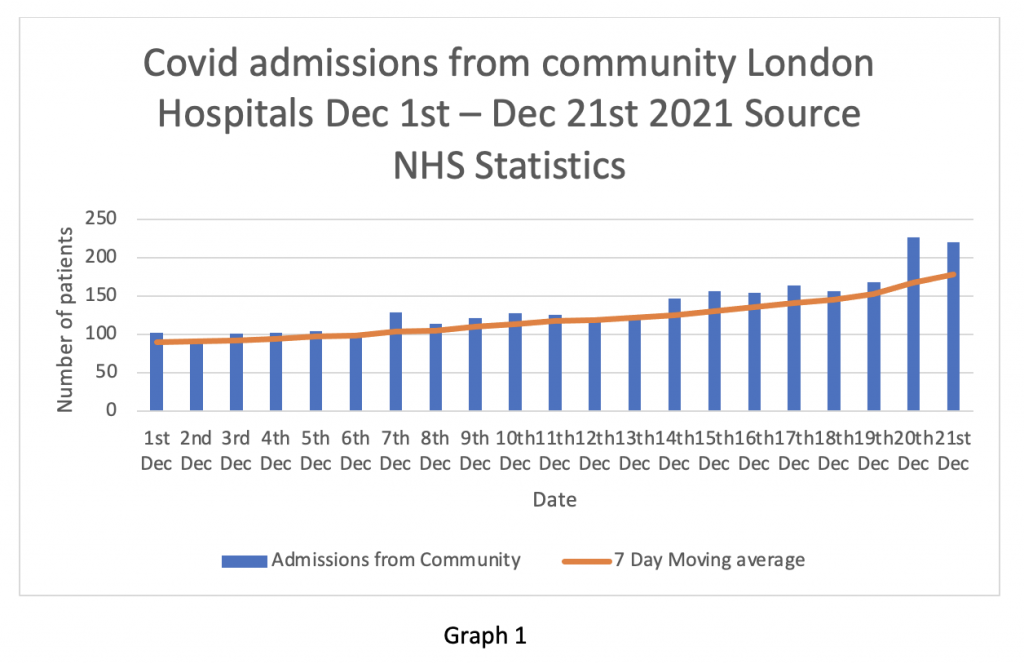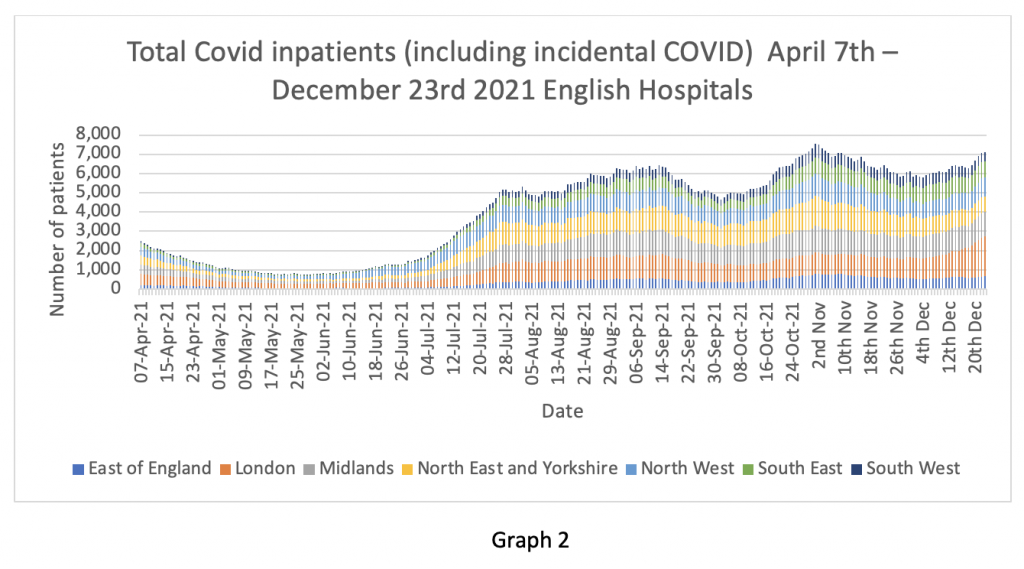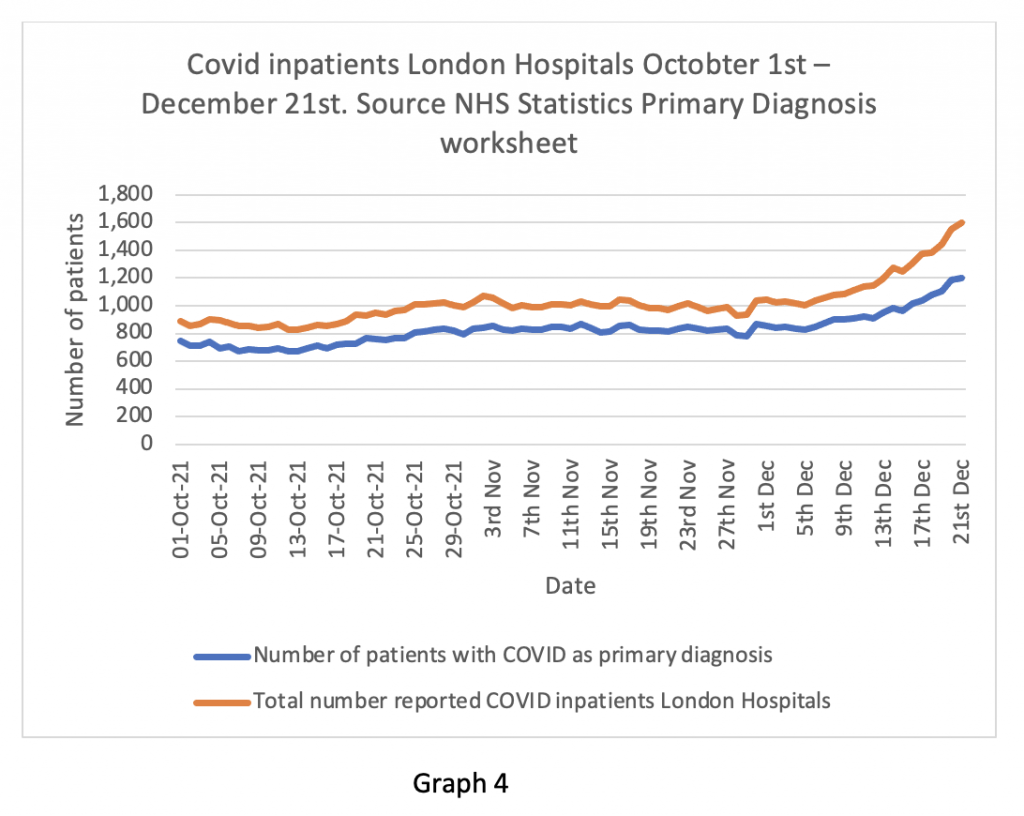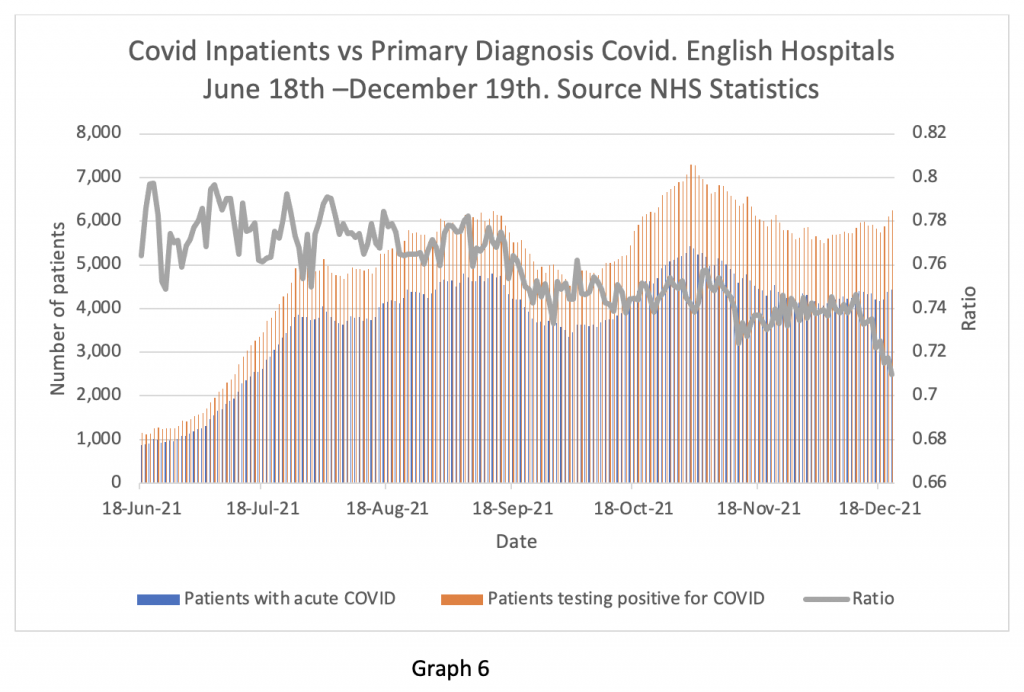We’re publishing a guest post by our in-house doctor, formerly a senior NHS medic, about the data released this afternoon. Does it support the claim that there’s a tsunami of Covid hospital admissions heading our way? Not really…
I have been asked to give a brief update on some interesting data released this afternoon. I hope readers will forgive a certain festive levity on my part and not consider it too inappropriate. For all I know we may be on the brink of a catastrophe. All I can say for sure is that it didn’t happen today.
Since Professor Whitty predicted at the Downing Street press conference on 15th December that ‘Records will be broken a lot in the next few weeks’, we have been glued to the numbers even more tightly than before. On Thursday afternoons a couple of large data packets are released by the NHS. They contain some surprising information.
Many expert colleagues have been predicting portents of imminent doom on the airwaves in the last week or 10 days. I have heard terms like ‘tsunami’ and ‘avalanche’ used to predict the coming wave of Covid admissions. Being a humble clinician and not an expert epidemiologist, I defer to my specialist colleagues on these points.
Graph 1 shows the extent of the avalanche so far in London, the epicentre of the Omicron wave in the U.K. I have graphed admissions from the community with Covid in London from the December 1st so readers can see for themselves the severity of the catastrophe.

I have been unable to find a quantitative definition of ‘avalanche’ in terms of Covid patients. What we can observe is that the seven-day moving average has increased from 90 patients per day on December 1st to 178 patients per day on the 21st. So about double in three weeks. If it carries on like this, by mid-June of 2022 there will be 91,136 new patients admitted with Covid every single day and the entire population will be in hospital.
There are about 20 acute general hospital Trusts in London, so at the moment about nine Covid patients per day each. Its fair to say that the admissions are not spread evenly across the capital. Most admissions are concentrated in the East and South-East of London. This may have something to do with lower percentages of vaccination in those areas. Anyway, this is clearly the foothills of the impending deluge which will certainly be along soon.
Graph 2 shows Covid inpatients across all hospitals in England as the Omicron avalanche makes its way through the nation with its fabled rapid transmission rate. Readers will observe that numbers have risen a little, mainly due to increases in London, but we are not yet at the peak seen earlier in the year. My expert colleagues tell me that we will shortly have more than the 26,000 COVID hospital patients than in January of 2021. It’s just a matter of time.

Regular readers will recall that in previous waves the serious pinch point was in ICU because resources in high dependency medicine are quite limited and difficult to expand quickly. Graph 3 shows the ravages of the Omicron wave so far. It is important to note that there is a lag between a patient catching Covid and becoming ill enough to require an ICU admission. But that’s just a temporary lull while Omicron gets itself together.
So far there has been a fall in ICU cases in England during December, and there are currently fewer cases in English ICUs than there were in August. ICU Covid bed occupancy in the stricken capital city has fallen from 210 a week ago to 196 this evening.
No one should take comfort from the observation. The tsunami will certainly arrive in the next week. Possibly two. Or maybe three. Professor Whitty says it is “nailed on”, so it will certainly happen, right?

The really interesting data released today was from the Primary Diagnosis spreadsheet. Readers may remember that this distinguishes between people suffering from acute illness with Covid (blue line) and patients admitted for other reasons but with an incidentally positive Covid test (orange line). Graph 4 shows the data for London as the Omicron wave devastates the capital.
Readers will note an increase in cases from December 1st. The fascinating observation is that incidental cases are rising faster than acute cases – the ratio between the two continues to drop. What this means is that although we are seeing more people with positive tests in December, a relatively smaller proportion of them are actually ill with Covid. The rise in patients actually ill with Covid in hospital has so far been relatively modest. Of course, that will not last, according to the SAGE modellers. By this time next week the NHS will be inundated with thousands of desperately ill people with Omicron.
Some doctor friends of mine say Graph 4 shows that Covid “is the passenger, not the driver”. I think they mean Covid isn’t the main reason people are in hospital – but they are the inferior and slightly dim sort of doctors that just treat patients and can only see what is going on at the present time. They are not clever experts in epidemiology and public health who can predict the future. We watch this space with great interest in the next few weeks as the avalanche inevitably picks up speed and overwhelms the NHS.

Graph 5 is particularly interesting and a bit ‘busy’ so I will talk you through it slowly. It shows a comparison between patients admitted from the community with acute Covid in the orange bars and patients contracting Covid in hospital plus admissions in the blue bars. The grey line is the ratio again. Graph 5 shows that Covid admissions have gone up substantially since the beginning of December, but that Hospital-acquired infections have gone up a lot more. This fits with what the experts have told us – that Omicron is a lot more transmissible. It seems to be more transmissible in hospital than in the community. I wonder why that might be?

Graph 6 shows the same data across the whole of England and the trend is even more pronounced than in the London data. Overall, in England, admissions from the community with Covid are flat. However, the number of people acquiring Covid in hospital has increased. I wonder if this is what my expert colleagues mean when they refer to an ‘avalanche’ of Omicron?

As you will have heard on the media, it’s very early days in the evolution of the Omicron variant in the UK. We can assess data from South Africa and several other European countries, all of which show that so far the hospital admission rate is far lower, the requirement for ICU care much less and deaths virtually zero from the new variant compared to the Delta variant. But we cannot extrapolate from those countries to make an predictions about the U.K., right? In fact, all the U.K. data I have seen has a remarkable consistency in suggesting that Omicron is less likely to put patients in hospital, especially if they are vaccinated, less likely to require ICU care, causes a shorter hospital stay and has a much reduced risk of death.
On the other hand, my expert colleagues caution against complacency. I am informed that the British population is different from all the other human groupings so far attacked by Omicron. Britons are older, sicker, fatter and more prone to viral infection than people in South Africa, despite a higher level of vaccination. In fact, the new deadly and highly transmissible Omicron variant can escape vaccine protection. So, it is essential that everyone immediately gets vaccinated.
Various colleagues have taken to describing the Panglossian optimism about the new variant being less dangerous than Delta as “Hopium”. (Some doctors find that pun amusing.)
We are assured that the NHS might still be overwhelmed in the coming weeks, hence it is essential that the entire population stay indoors for the foreseeable future until the danger has passed. Not staying at home is immoral and means you are a bad person. The expert doctors will let people know when it is safe for them to come out. This may take some time.
People experiencing symptoms similar to an upper respiratory tract virus (runny nose, sore throat, headache, etc.) may actually be suffering from Covid rather than an inconsequential seasonal cold.
So, readers must not under any circumstances fall into the trap of complacency. Some of you may be completely unaware that you have contracted this deadly disease, so you must take regular tests to check. That runny nose and tickly cough could be the highly transmissible Omicron variant and you must notify the authorities immediately. Those police officers knocking on your door are protecting the public from hazardous sneezing. Anyone you have spoken to in the last few days must stay at home in case they infect others, lest the ‘remorseless logic of exponential spread’ overwhelm our beloved NHS. If you fail in your obligations as a citizen to protect others, you are an enemy of the state and a danger to society.
Because one can’t be too careful these days.
Next week the tsunami will arrive for sure.














To join in with the discussion please make a donation to The Daily Sceptic.
Profanity and abuse will be removed and may lead to a permanent ban.
Good article. In summary, if you let morons formulate policy which they are then allowed to enact, don’t be surprised at the almighty cluster**** that inevitably ensues.
Excellent article. Progress reflects human resolve and ingenuity prevailing over risks to life and limb.
Health, wellbeing and life expectancy correlate with sanitation, running water, mains electricity, supplies of gas and nuclear power, the Haber-Bosch process and overall economic prosperity. Likewise the clean environment green zealots bang on about ad nauseam.
The Politburo doesn’t get the basics of how hundreds of years of social, technical and industrial progress lifted the developed world out of the squalor and tyranny of feudalism. Reliable, affordable and unbounded energy supply was, and still is, fundamental to progress.
The Student Union Government is instead fixated on the ramblings of those ne’er do wells, Marx and Engels, that may have had some 19th century relevance, but are now ancient doctrine gone rancid and sour.
Predicated on climate claptrap and energy folly, a Great Leap Backwards beckons. Witness Western European economic mass insanity.
The Kommissars Must Fall.
All true, but…
“The Politburo doesn’t get the basics of how hundreds of years of social, technical and industrial progress lifted the developed world out of the squalor…”
The lions share of human advances took place in just the last 200 years. Please see Buckminster Fullers chronology of the Industrial Revolution below using the Periodic Table as a key reference. Notice also the number of inventions. The abolition of slavery was in 1830 around the same time as the Factory Act 1832. Notice also the change in transportation across the top. My Father was born 12 years after the Wright Brothers first flight and before he retired Humans had been to the Moon.
Agreed, progress really took off in the last two hundred years. With a bit of imagination. I can just about relate to the world of 1854 (year of one of my great grandmothers’ birth), but not to the world of a century earlier than that. Great Grandma’s life likely began in the era of wells and middens, and ended in 1937 in a house with mains electricity.
I’d argue, however, that the seeds of the 1830s onwards were set by the advances in scientific thinking of Boyle, Hooke, Newton et al, that began around the 1660s. Foundational era of the empirical scientific method. Let there be Light, let there be Enlightenment.
True. We should also include Magna Carta, the Lollards, the English Bible, the Reformation and I think the pivotal English Civil War. The change from an Autocratic monarchy as well as the affects on working practices caused by the plague took the brakes off. Cromwell had already started the agricultural revolution with the draining of the Fens. When King Charles II was restored to the thrown he tried to restore the authority of the Monarch and get us back into Europe, or rather the Roman Catholic Church, and failed on both counts. He tried to shut down the coffee houses in London where all could meet, talk and trade without regard to status, or even gender and he failed on that too. Monarchy and to a large extent the aristocracy became irrelevant. The first commercial steam engine was in 1710, a mere 50 years after the Restoration, and 17 BEFORE the last women was burned as a witch. All nations up to this point were powered by men, horses, and sail. The steam engine was a multiplier and it is significant that engine power is still measured in horses.
“The Kommissars Must Fall” oh they will just a matter of when and how much devastation they cause in the meantime.
Purely using common sense it would seem the lower end of the variables more likely when it comes to deaths caused
The amount of land effected and its effects on humans living on it afterwards is almost impossible to calculate
I would say nuclear is nowhere near as dangerous as is proposed by the green blob and I would certainly prefer it to acres of wind turbines and solar panels
Nuclear waste, which is partly recyclable, is another conversation that needs being opened up to public debate instead of being instantly used as a big stick by the blob
We really do need grown ups in power at the moment, like never before!
Unfortunately the grownups are sadly lacking or swiftly put to the sword – metaphorically speaking.
The world needs energy. We always hear of the risks of using certain fuels but NEVER about the risks of NOT USING THEM—–Without coal gas oil or Nuclear we are back in the middle ages and going to work on a horse, dying young of preventable disease and of injuries caused by back breaking labour. —–There are forces to day trying to control energy use, and infact almost everything else human beings do as well. —-GREEN = RED.
Presumably judging by your last comment you have read James Delingpole’s Watermelons (or perhaps you ARE James Delingpole ).
).
There has been no shortage of anti-nuclear output about the Chernobyl disaster, but it appears that the design of the particular type of reactor had a built in risk, and they fell foul of it during it’s operation, or maintenance thereof. Not all of the stations in the ex-USSR are the same.
Historically, the old USSR was quite keen on the use of electric traction on it’s railways. Back in 1996, I travelled from Beijing via Mongolia then into Russia and all the way as far as London by train, and once we were on the Siberian route after the Mongolia/Russia border, it was all overhead electric (via Moscow, Warsaw, Berlin, Köln, Brussels). You can travel all the way from the Pacific across the continent that way. You can’t do that across the pond!
That sounds fantastic – a trip of a lifetime!
Central planning is lethal.
45 million people died as a result of Mao Zedong’s Great Leap Forward – perhaps the greatest number of deaths attributable to the folly of a single man (or small group of people.) To be clear, those were unintended, accidental deaths.
For comparison, 36 million died in WWII and 13 million in WWI.
Allowing a few people to exert immense power and influence over many others is just really dangerous and should not be allowed. It almost always goes wrong at some point. That is the single most compelling argument for small government, in my opinion.
Central Planning is fab, or so i heard on the BBC the other day. People don’t want EVs, so sales are only 21K monthly as opposed to the 28K mandate. Manufacturers can’t manufacture them profitably, and have thrown over £4bn trying to shift the ones they can’t sell.
So, said the man on the news, if the motor manufacturers can’t make them affordable, “the government will have to step up to the plate.” Meaning, of course, that because the public can’t afford them, they’ll have to pay for them anyway through taxation.
So if we are to lead the way to saving the planet, central planning is the sine qua non.
In passing, I heard a story via a friend of someone trying to buy a normal white diesel van for his business (still going). The dealer couldn’t let him have one until he had managed to sell a quota of Electric vans – so over a year he was able to ‘release/sell’ only 3 ‘normal’ vans as EVs don’t sell very well. How on earth have we managed to achieve this?
Everyone seems very keen on Latin today.
It’s yer actual classical education innit? Courtesy of J. Caesar you get to learn how to make accurate measurements with a water-clock without a Lithium battery in sight. Noli illegitimi carborundum.
On the upside he’s also the greatest drug reformer in history. Prior to his coming to power there were millions of opium addicts in China. By executing dealers AND those caught using it there were very few opium users left by the time he died.
Yesterday’s Reform Press Conference on the subject of “renewable energy” and the Net Zero scam is worth watching.
https://www.youtube.com/watch?v=WxTrWTWBoM4
Thanks. I will try to work my way through it, though so far disappointed that they are using the term “renewable” without qualification as I think it’s misleading. But perhaps they cover that later.
In the surrounding forests around Chernobyl there are no 2 headed wolves or five legged dear or deformed trees, or any deformed life. This also means It is also not a desolate wasteland devoid of life.
Not far above Las Vegas is Area 51, and a couple of valleys to the West is one of the United State’s nuclear test ground. I’ve attached below a Google Earth screen grab of this area. Each crater is from a nuclear test. It is possible for people to visit.
Didn’t Clarkson visit Chernobyl on one of his Top Gear tours? They all seemed to have survived.
Absolutely first class. So much information packed in to this article. It’s like a Roman banquet.
Thank you.
We owe the “linear, no threshold” model to Hermann Muller, who knew it was false as he collected his Nobel Prize from research by his own team members. It has somehow become an axiom in many sciences, even though in fact it has never been demonstrated scientifically because it is, indeed, false.
It’s not only irrational fear of radioactivity that has been fostered by this (in that case, directly by Muller’s advice to the US government). Muller used it first to make the case that, since heavy radiation causes genetic mutations (hence the Incredible Hulk!), Darwinian evolution would easily work by stray radiation causing tiny, selectable, mutations.
That forms the basic assumption of modern evolutionary theory, but is as untrue as the death estimates from nuclear accidents.
But consider also PM2.5 particles in diesel and other air pollution – ALL the supposed deaths are based on linear no threshold.
On the other side, how do you think proponents of fossil fuels in developing countries estimate the deaths caused by cooking over open fires? Do they count respiratory illnesses or bodies? No, more estimates of toxicity based on linear no threshold.
Likewise when the EU and other regulators ban fertilizers or other chemicals… same reasoning.
I remain convinced that one of the central aims of Nut Zero is depopulation.
‘there is no such thing as a safe dose of radiation’.
The curse of safetyism writ large for the purposes of control.
According to Wikipedia:
Oh dear, even living isn’t ‘safe’.
Maybe that’s why the eugenicists want to kill us all.
Excellent article – the only point I would take (minor) issue with is “And that’s before we’ve even considered the further consequences of rising energy prices, such as unemployment, living in a cold home, reduced levels of public services and so on.” Doesn’t the previously quoted £238 per year income/month of life expectancy ratio already explain/account for that?
“Greens get very worried about the risk of nuclear accidents. But have they considered that the economic devastation of Net Zero will cause far more deaths than were ever suffered by Ukraine after Chernobyl, asks Ben Pile.”
And I ask Ben Pile have you considered economic devastation and many deaths is exactly what Greens want?
Ben Pile is a constant voice of reason. I do hope that his lucid, referenced pieces resonate far more widely than merely in the (inevitable) echo chamber of this forum.
A good read, thank you.
Excellent article and a very useful statistic to counter the “you can’t put a value on granny’s life” covid claptrap from the so called conservatives. Arguably you confuse annual and capital spending but it’s a great point nevertheless!
The photo in this article says it all. This part of the world is dead.
I’m all for nuclear, but the article really cannot make its claims without looking at the history of nuclear accidents in Britain (and their coverups), particularly the Windscale event.
I keep writing to the RSPB about the carnage being brought to bird life in name of Green energy and all i get back are “party line” replies, and now they are saying that solar farms will actually enhance birdlife..! So why not glass over the whole country and see how that goes!. Please can folks here write to the RSPB in hope that its not just me saying this to them, as they probably regard me as some sort of annoying crank.